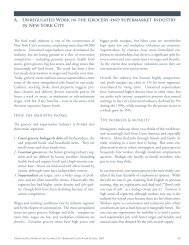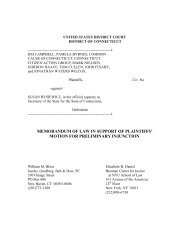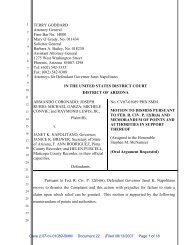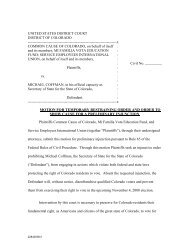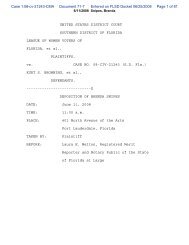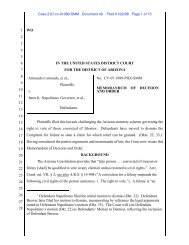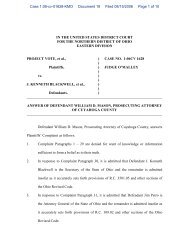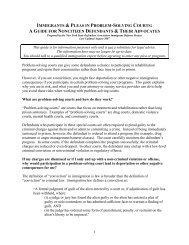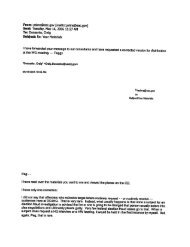you can do with the pages of Time and Newsweek,in terms of transferring images, I tell them thatthey better get permission first. I try to cover mybehind, but I never get permission.”Sandra Camomile added: “[Marcel] Duchamphappens to be one of my huge influences, andI think that his appropriation of the urinaldefinitely steps on somebody’s design work.When I pull images off the Internet, I’m usingfound objects.”Joy Garnett uses a similar process, drawinginspiration from photographs, often anonymousones, for the imagery in her paintings. “Partof the subject of my work is the relationshipbetween found sources, such as photographs,and the transformative act of painting.Originally, I had gone from science imagery todeclassified government imagery. None of thatwas problematic. Then I did a project where Istarted pulling images from the mass media,mostly from the Web. I mounted a show inJanuary 2004 of about eleven paintings, ofdecontextualized figures pulled from news wiresand Web sites. The show was called ‘Riot,’ andthe theme was people in extreme emotionalstates. It was all kinds of people – fighter pilotsand guardian angels; skinheads rioting. Thesources are forgotten; that’s part of the process.“One of the paintings, kind of the centerpiecefor the show, was a picture of a guy in a beretwith a cross around his neck, and he’s throwinga Molotov cocktail; he has a ponytail and helooks like a hippie. And he’s really big; it’s a bigpainting. So we made that the invitation card,and we sent it out.“Halfway through my show, I get this emailfrom an acquaintance. The subject line was thename of a famous Magnum photographer, andthe content of the email was, ‘She’s coming tomy studio next week. Your card is on the wall. Iassume you asked her permission.’“And I was like, ‘What are you talking about?’He sent me the URL to Magnum, and I foundthe original image that my fragment, whichI had found on some anarchist Web site, wasfrom. It was a 25 year-old photograph by SusanMeiselas that was part of a famous book she haddone in 1981, called Nicaragua. I wrote backsaying, ‘I didn’t even know. How could I ask herpermission? I wouldn’t have asked her permissionanyway.’ I mean, implicit in that would be thatfor every moment of my creative process, Iwould have to be concerned with finding theauthors of these photographs, contacting themfor permission, and dealing with their attitudesabout permission.“I didn’t contact her. A week after the showcame down, my gallery and I – we have imageson our Web sites – we each get a cease anddesist from Susan Meiselas’s lawyer saying thatthis painting ‘Molotov’ is a derivative workbased on her copyrighted photograph, that Ihad pirated the photograph, and that I hadto sign a retroactive licensing agreement thatwould sign over all of my rights to the paintingto Susan Meiselas in accordance with Magnumcopyright derivative works formalities. And ifI wanted to show, sell, or reproduce the imageagain, it wouldn’t just require a credit lineto her, it would require that I got her priorwritten permission. 122“I was completely flipped out. So I did twothings. I contacted a really good copyrightlawyer. And I went on to my discussion groupat Rhizome, 123 where only moments earlier we’dbeen discussing the Grey Album and sampling– this whole area of fair use remixing, licensing,and being sued. They were incensed on mybehalf. In the meantime, I went to my lawyer,who was also incensed. He thought that thiswas silly, that in terms of the four factors offair use, it could be argued either way, but themain thing was I had used only a portion of theoriginal. Whether or not an artwork is availablecommercially is not the whole issue. It’s alsocreative. It’s commentary. This comes under fairuse. It didn’t in any way change the market valueof the original.“So we wrote a very brief letter saying that Iwas sorry; that I was not aware that I had chosenher photograph; that I was not interested inusing seminal iconic famous photographs; thatI was interested in photographs that had beenlost. I suppose I was guilty of not recognizingher photograph. But it was famous in 1981,and I was little then. I wasn’t around during theSandinistas. I also mentioned that I was hurtby being accused of copyright infringementwhen in fact I had transformed the work, and22 Will Fair Use Survive?
that painting is all about quoting, referencing,copying. And I have my precedents in thecontemporary art world, painters who usephotography. So we I said I would not sign theform giving her rights to my work, because Ihave something to protect as well. 124 And infact, that’s when I began to get mad, instead offeeling like maybe I’d done something wrong.We sent out this letter, and discussion is stillraging on Rhizome.“A few days later I get a 12-page veryaggressive response from the lawyer saying thatinstead of waiving their licensing fee, now Ihave to pay $2,000. And that there was all thiscaselaw, as though she’d cut and pasted fromCopyright 101. It didn’t make any sense, and Ididn’t think it related to what I had done. Butit was incredibly intimidating and my lawyeragreed. He was surprised that we got that kindof response because our letter was very politeand reasonable, and it was an apology. 125“Now I believe that the whole thing was justa scare tactic to get me to take the stuff off theWeb. And it worked. I called my lawyer and saidI was taking my images off the Web site becauseI didn’t want them to go to my Internet provider.I didn’t want my Web site pulled. This is whatI was really afraid of, because I use that site tosend images to galleries, to writers, to critics.“But here’s the punch line. Seconds before Itook the images off, people on Rhizome grabbedmy images in solidarity. They uploaded my pagesto their Web sites; then one of these artists takesmy painting and flips it. He puts it up on his site,and now it’s a derivative work based on my work.And everyone started making digital collagebased on the Molotov image. It all turned intoprotest art. For the next five months, this imagewent global. So there are a couple of morals tothis story. The idea that you can control what’sgoing on right now in the digital realm with theolder paradigm of copyright control is gone.The ideas of the new technology are part of ourculture whether or not we’re aware of it.” 126At the end of this story, Talbot remarked: “Itseems to me you’ve created a wonderful situation,because I can only imagine her trying to pay herlawyer to send the same kind of letters to thosethousands of people. She could never have doneit. So you took it out of your personal role andmade it a worldwide thing, and you’ve coveredyour behind.”Joy Garnett, “Molotov”Garnett replied, “Well, they did it for me. Itwas nice. But it was not about me. It was aboutthe issue.”Publishing is another area fraught withdifficulty for these scholars and artists. FrimaFox Hofrichter, an author of art books, said thatwhen she has needed images, she has alwayssought permission, unless the publisher tookcare of it. Years ago, when she was writing abouta then little-known 17th century artist, JudithLeyster, two collectors denied permission toreproduce specific works, “and I did not usethem,” even though “other art historians said Icould have used them.”What made her decide not to?“Because I asked. And I thought once I asked,then I was obligated to follow what they said,which is why people don’t want to ask.” 127To this, Talbot replied: “One of my reasonsfor not asking is that I sell little collages for $400,which may have 30 images in them. I don’t maketime to go asking questions for something whichsells for $400. Sometimes I get only $200. If I’mBrennan Center for Justice 23
- Page 1 and 2: WILLFAIR USESURVIVE?Free Expression
- Page 3 and 4: WILLFAIR USESURVIVE?Free Expression
- Page 5: ContentsExecutive Summary . . . . .
- Page 9 and 10: unhappy years of World War II.” 1
- Page 11 and 12: Although §512 does allow an ISP
- Page 13 and 14: music, distance learning, interlibr
- Page 15 and 16: CHAPTER 1The Legal LandscapeThis ch
- Page 17 and 18: Court’s “Oh, Pretty Woman” de
- Page 19 and 20: the public would be confused about
- Page 21 and 22: CHAPTER 2Quoting Sartre, Using Prok
- Page 23 and 24: owned by Gallimard [the French publ
- Page 26 and 27: well, this and this person gave it
- Page 30 and 31: going to start writing letters for
- Page 32 and 33: causing problems for our communitie
- Page 34 and 35: or Not’ people. So we took it dow
- Page 36 and 37: The American Pool Players Associati
- Page 38 and 39: “Paris Hilton Sex Tape” 150 (ho
- Page 40 and 41: howardhallis.com,” a comedy and c
- Page 42 and 43: legitimate borrowing of protected m
- Page 44 and 45: Dan Hamilton, managing editor of th
- Page 46 and 47: legal action as long as eInfoworld
- Page 48 and 49: At that point, Cox took to the blog
- Page 50 and 51: her books, but not created by Anne
- Page 52 and 53: CHAPTER 5Internet Infidels and Home
- Page 54 and 55: she attributed to the many form let
- Page 56 and 57: “Without his permission, the gove
- Page 58 and 59: eproducing an artwork in a book wit
- Page 60 and 61: ConclusionWhat can we learn from th
- Page 62 and 63: Reiff thought that instead, the gov
- Page 64 and 65: Endnotes1 Mattel v. Walking Mountai
- Page 66 and 67: 48 See Katie Dean, “Eyes on the P
- Page 68 and 69: 109 Not an exact quote. See Alan Al
- Page 70 and 71: 149 http://msophelia.blogspot.com/p
- Page 72 and 73: 215 “MBA Legal Defense Initiative
- Page 74 and 75: lank left hand page
- Page 76: 161 Avenue of the Americas12 th Flo




![Download the Letter [PDF] - Brennan Center for Justice](https://img.yumpu.com/50139248/1/190x245/download-the-letter-pdf-brennan-center-for-justice.jpg?quality=85)
